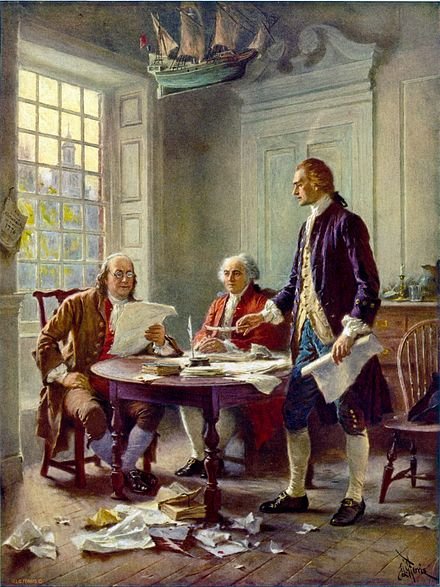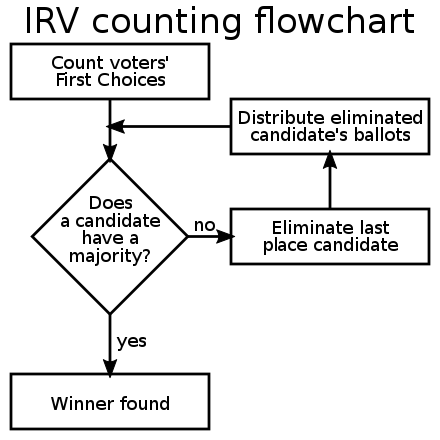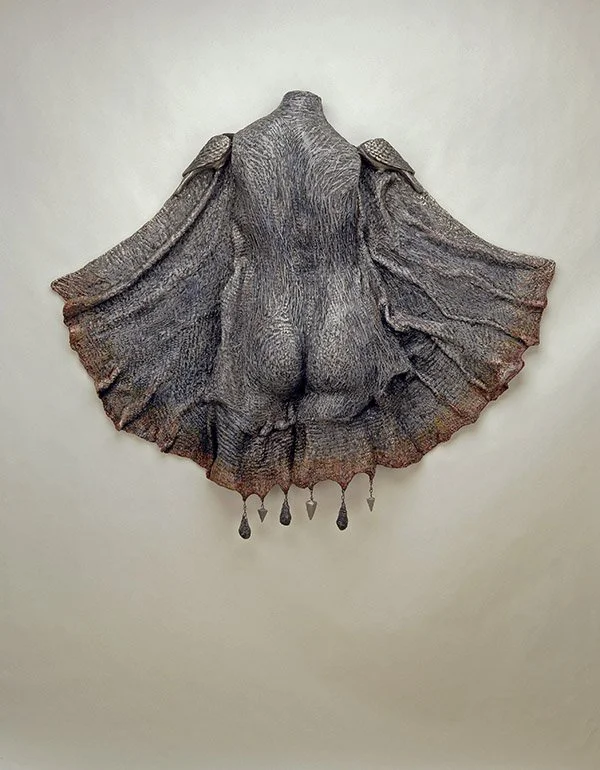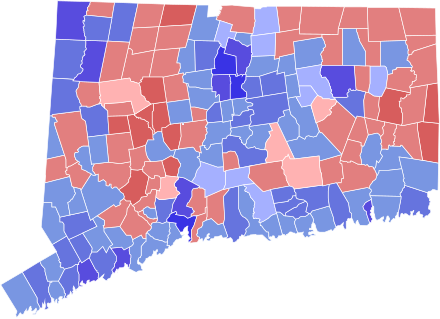‘Somatic responses’
Selections from Maggie Nowinski’s show “Cicatrix/In Bloom,’’ at Tremaine Art Gallery, at the Hotchkiss School, Lakeville, Conn., through Oct. 15
Maggie Nowinski is a Massachusetts-based multi-modal artist, teaching artist and curator Maggie Nowinski.
The gallery says: “Through her work, Nowinski ‘explores somatic responses to environment, internal and external passageways, and collected disturbances through imagined specimen drawings that depict abject human-botanical entities’ with line drawings, prints, found objects and sound.’’
The Litchfield Hills and Lake Wononscopomuc, as seen from the grounds of the Hotchkiss School, Lakeville, Conn.
Chris Powell: Misappropriating flagpoles for proselytizing
The “Christian flag’’ at issue
A “Rainbow” or “Pride’’ flag promoting LGBT interests
MANCHESTER, Conn.
Misappropriation of government flagpoles for political purposes continues in Connecticut. Torrington Mayor Elinor C. Carbone has approved a request to fly a Christian flag at City Hall for two weeks. It's part of a national campaign to urge people to go to church, particularly Christian churches.
This has commandeered the government for religious proselytizing, the sort of thing done in medievally totalitarian countries.
Of course, most recent flag controversies in Connecticut have involved commandeering the government to celebrate certain sexual orientations, as if sexual orientation isn't as much a personal matter as religion and as if Connecticut law doesn't already guarantee freedom of sexual orientation as well as religion.
Such use of government flagpoles is said to advance "inclusiveness" but it is actually divisive. Not everyone is Christian and no one needs to be told by government to go to church. Such an intrusion into personal matters is offensive.
As for the sexual-orientation flags -- “pride” flags -- their advocacy extends far beyond equal rights. They are construed to support transgenderism and the overthrow of gender privacy in bathrooms and equal opportunity for women in competitive sports. Most people oppose those things.
Additionally, as Torrington and many other municipal governments should know, courts have ruled that if government allows outside groups to use its flagpoles, it may not discriminate. If a government grants one request, it must grant all requests, as any refusal is unconstitutional censorship. This is how manger displays on town greens and public parks at Christmastime have compelled acceptance of atheist displays.
What will happen when someone wants to fly a Ku Klux Klan or a Nazi flag at City Hall, or flags advertising car dealers, supermarkets, or political candidates? The Trump 2024 flags are ready to go.
The only flags that can be "inclusive" on government flagpoles are government's own -- flags that fly for everybody.
xxx
Also being misappropriated in Connecticut are the electricity rates charged by utility companies.
At the direction of the state Public Utilities Regulatory Authority, the state's two major electricity distributors -- Eversource and United Illuminating -- are offering discounts to poor customers who are receiving financial support from state government like Medicaid insurance and food subsidies.
Norwich Public Utilities, the electric company owned by that city, is considering its own program of discounted rates for poor customers, the discounts to be determined according to household size and income.
Such discounts will be financed by customers who don't get discounts.
The intent here isn't necessarily objectionable but the method is. For these discounts will be public welfare expenses and as such they should be borne plainly through general taxation, not hidden in the bills of other electricity customers.
Already 15 to 20 percent of the charges to electricity customers in Connecticut arise not from the cost of providing electric power but from various social programs and policies state government has decided to finance through electricity bills so resentment will fall on the utility companies rather than elected officials. Connecticut faces nearly the highest electricity costs in the country in large part because state government hides so much of its own costs in electricity bills.
This doesn't mean that electric utilities shouldn't economize. It means that elected officials are grossly hypocritical when they accuse the utilities of overcharging even as state government does more overcharging for electricity than the utility companies do.
PICKLEBALL TAKES PRIORITY: Amid brazen crime and worsening poverty, mental illness, drug addiction and homelessness, Connecticut seems to be falling apart, as does the country itself. But last week Gov. Ned Lamont took a break from those problems to help open the four new pickleball courts in Glastonbury.
The courts were financed with state and federal money, as well as municipal money. Glastonbury, prosperous and well-insulated from social problems by its zoning regulations, could have covered the whole cost itself, without state and federal aid, if the courts were really essential to the town's well-being. But setting humane and sensible priorities in government can be such a drag.
Chris Powell has written about Connecticut government and politics for many years. (CPowell@cox.net)
Chris Powell: City-operated supermarket in Hartford? UConn seems to condone rape
If only….
Hartford in 1914, during “The Insurance Capital of the World’s’’ economic heyday
MANCHESTER, Conn.
Hartford’s long descent from a prosperous hub of industry and finance (especially insurance) to a repository of poverty can be measured in several ways, but an especially telling one was publicized the other day as the City Council decided to hire a consultant to consider having city government operate a supermarket in the city, for profit or even at a loss.
Hartford is said to have become a "food desert," a place whose residents have to travel far to obtain fresh and nutritious food for preparation at home and so have to rely on less healthy items from neighborhood convenience stores. According to The Hartford Courant’s report on the supermarket initiative, in 1968 the city had 13 chain supermarkets but has only one today.
The idea of city government supermarkets is also being pursued in Chicago, where crime is exploding and destroying the city.
Like other businesses, supermarkets won’t operate where they can’t make money safely. They won’t operate where people don’t want or can’t afford fresh and nutritious food and where crime is common.
If, as the City Council’s initiative suggests, Hartford is, like Chicago, now so desperate that government must provide food directly to its residents, the problem goes far beyond a "food desert." The problem is demographic collapse under the pressure of poverty, welfare policy, family dysfunction and poor education -- and government in Connecticut does not seriously examine those things.
Hartford’s government can’t be blamed much here. Cities are the product of their demographics, and their demographics are largely the product of state and federal government policy, which long has been content to concentrate poverty in the cities, to minimize its impact on the middle and upper classes, rather than eliminate it. Indeed, Hartford may be doing all it can just by facilitating construction of middle-class housing downtown, since eventually a middle-class population with enough density might attract not only supermarkets but also other businesses basic to middle-class life.
But this will be a struggle even with a proper housing policy as long as the city’s schools serve mostly disadvantaged students and remain unattractive to people who want to avoid or escape the culture of poverty.
Would Hartford operate a supermarket professionally, or would such a supermarket become another mechanism of political patronage and graft? The less profit such a supermarket would have to make, the less professional it would be.
Middle-class places don’t need government supermarkets. Middle-class places can pretty much take care of themselves. So where is state government’s plan to make Connecticut’s cities middle-class again instead of just sustaining poverty there?
xxx
No one needs to be a feminist to deplore the University of Connecticut’s new association with the late professional basketball star Kobe Bryant. But it would be nice if a few feminists at least took notice\
Sports apparel manufacturer Nike announced the other day that it is renewing its “Kobe” brand of basketball shoes and other items, perhaps eventually including college basketball jerseys, and that six college basketball programs will promote the brand, UConn's among them
A statement from UConn’s athletic department, with which university President Radenka Maric concurred, said: "We are proud partners with Nike, whose support benefits hundreds of student-athletes at UConn every day. Kobe and Gigi Bryant" -- the star’s daughter, who was killed with him in a helicopter crash in 2020 -- "were tremendous fans of UConn basketball, and we're pleased to join Nike in honoring their memory in this way."
The problem is that in 2003 Bryant was charged with raping a young woman employee of a hotel in Colorado after luring her to his room. While he insisted that their encounter was consensual, the details he admitted about it were violent and disturbing. Eventually the woman declined to testify, so the charge against Bryant was dropped, whereupon she sued him. He apologized and settled the case for what was estimated at $2.5 million.
Money apparently excuses everything, even rape and even at UConn, which ordinarily prides itself on political correctness.
Chris Powell has written about Connecticut government and politics for many years. (CPowell@cox.net).
Chris Powell: Government and other villains in Conn'.s medical-insurance price surge
Logo for Connecticut’s health-insurance marketplace
MANCHESTER, Conn.
Who and what are to blame for the soaring cost of medical insurance in Connecticut? A couple of weeks ago, a hearing held by the state Insurance Department heard opinions in response to more requests from medical insurers for premium increases, this time averaging 20 percent for individual policies and 15 percent for small group plans.
Of course, the country's general inflation rate is a big part of the problem. But the costs of medical insurance are especially complicated, since for many years government's intervention, necessary as it may be, has turned medicine into a carnival of cost-shifting, so much so that people can hardly know the real cost of what they're getting and who is really paying.
Elected officials blame insurers, who blame hospitals and doctors, who blame insurers and government. They're all correct, though exactly how much each is to blame isn't clear.
But start with government because of its direct accountability to the public and because government is the biggest purchaser of medical insurance -- for its employees, for the poor via Medicaid and for the elderly via Medicare.
Government's payments for Medicaid and Medicare patients are sharply discounted from rates paid by other patients. The point of this discounting was to shift costs to those other patients and hide them. Exactly how much costs are shifted is debated. But if government paid more for the poor and elderly, hospitals and doctors could charge other patients less and insurers could reduce their rates -- at least theoretically.
But saving money in medicine and medical insurance may require competitive markets even as those sectors have greatly consolidated.
Most Connecticut hospitals are now owned by two chains -- Hartford HealthCare and Yale New Haven Health -- and hospitals have been acquiring or partnering with physician practices, further diminishing competition. This consolidation has been attributed to the growing burden of government regulation and the desire of doctors to do less paperwork and more patient care.
Meanwhile, insurance companies have merged and gotten bigger or left the medical insurance business. Only three insurers are selling individual medical policies on Connecticut’s Affordable Care Act exchange in Connecticut, and one insurer has reported big losses in the last two years. That company may not be looting its customers as much as the haters of insurance companies like to believe. But if medical insurers really have excess profits, government could always tax them away.
How hard are medical insurers negotiating with hospitals and doctors? At the recent hearing, state Atty. Gen. William Tong complained that insurers are not negotiating costs but rather building their rates on mere estimates of annual cost increases. Presumably state law could require insurers to seek specific rates from hospitals and physicians for a year or two in advance, if hospitals and physicians were willing and able to provide them and stick to them. They're probably not.
Also driving up medical-insurance costs are state government mandates for coverage that insurers must provide. Not all are necessities. Many are mainly matters of legislators seeking to gratify one constituency or another. Could state government reduce its medical insurance mandates? Not without a lot of shrieking.
(Meanwhile, state government's medical insurance for its employees and retirees spends $1 million a year for erectile -dysfunction drugs.)
Maybe the best suggestion at thd hearing was made by state government's departing health-care advocate, Ted Doolittle, who said that insurance companies are serving as a "stalking horse for the hospitals," the biggest parties in interest. Doolittle said hospitals should be interrogated just as closely as insurers and the hospitals raising costs most should be identified.
There's a lot of money in medicine and insurance, with many executives paid spectacular salaries, and the search for medical and medical-insurance coverage efficiencies is a largely political matter. So it should be the General Assembly's job more than the Insurance Department's.
Indeed, for just presiding over soaring medical-insurance costs, government is most to blame for them. But then, which legislators have the courage to risk offending not just two huge industries but also their many constituents who are patients?
Chris Powell has written about Connecticut government and politics for many years (CPowell@cox.net.)
Chris Powell: Saudi connection of governor’s wife; using old motels to help the homeless
The Saudi flag
MANCHESTER, Conn.,
During last year's campaign for governor, leading Connecticut Democrats from Gov. Ned Lamont on down may not have known that they were probably being hypocritical by criticizing the Republican nominee, Bob Stefanowski, for doing consulting work for a company connected to the Saudi Arabian government.
But now that it has been disclosed that the investment fund company run by the governor's wife, Ann Huntress Lamont, has a partnership with a Saudi government investment fund, try to find those Democrats.
The governor himself can assert that he didn't know about his wife's own connection to the awful Saudis and can note that the connection was listed in a public financial filing somewhere -- as if there is enough journalism left in Connecticut to review such filings promptly, and as if Mrs. Lamont's investment fund issued a press release about its Saudi connection any more than Stefanowski did about his.
Bad as the Saudi government may be, totalitarian and theocratic, it long has been a crucial financial and military ally of the United States, and Stefanowski had a plausible defense for his work in the country, which was to speed the transition from the country's oil-based economy to “green” hydrogen-based energy.
For all anyone knows -- Mrs. Lamont isn't talking -- her partnership with the Saudi government may have similar objectives. Or Mrs. Lamont's company may just be helping to invest some of the U.S. dollars that the kingdom has earned selling its oil to the United States and the rest of the world, oil purchases that long have implicated all Americans in Saudi totalitarianism.
Was Mrs. Lamont's company in partnership with the Saudi company even when her husband and his Democratic colleagues were denouncing Stefanowski for a similar connection? Maybe.
Did she not mention the irony to her husband? Who knows?
Since the hypocrisy and sleaze here involve Democrats instead of Donald Trump, will mainstream journalism let it drop?
xxx
Homelessness has risen in Connecticut for a second straight year, even as the state is full of hotels and motels that are operating at less than capacity or aren't operating at all.
City government in New Haven, where homelessness is acute, is aiming to acquire a local motel to turn it into "supportive housing," providing not only basic shelter but also connection to medical, psychological, and employment services.
Meanwhile, Danbury's zoning board is still disgracefully blocking a bid by a social-service agency to use a defunct motel for similar purposes.
Under-used and defunct motels and hotels are perfect for addressing homelessness. They require no extensive conversion to become “supportive housing” and are in commercial zones -- and lovely as summer in Connecticut is, winter will be here soon enough.
The homeless, many of whom are mentally ill or drug-addicted, have no political constituency. The economy is not half as good as elected officials claim after they manipulate economic data, and times are getting harder, so escaping from homelessness, addiction and long-term unemployment is more difficult than most people think.
Of course most state residents don't want "supportive housing" nearby any more than they want "affordable" housing nearby, since "affordable" housing can shelter not just young people starting out in life but also the demoralized, addicted, broken-down, and anti-social. But if Connecticut is to remain decent, these people have to be accommodated somewhere so they don't have to sleep under bridges and risk death in the street.
For many months now Governor Lamont has taken the lead with the motel in Danbury, issuing and renewing an executive order exempting it from city zoning. But the order has expired even as homelessness is worsening.
So the governor should use whatever emergency authority he can still muster, calling the General Assembly into special session if necessary, to authorize state government to acquire such property as necessary and to supersede municipal zoning to put a roof over the heads of the forsaken before winter arrives and help them restore themselves, and to ensure that no municipality has to use its own funds to do this.
Chris Powell has written about Connecticut government and politics for many years (CPowell@cox.net).
Chris Powell: Only obnoxious students justify teacher raises now; justice system runs on sometimes dubious plea bargains
Young student wearing dunce hat as punishment in 1906 photo
Latch-key kid of parents who aren’t home
MANCHESTER, Conn.
Student performance continues to crash in schools in Connecticut and throughout the country. The results of the latest National Assessment of Educational Progress tests showed steep declines in the reading and math proficiency of 13-year-olds. Students are doing worse than a decade ago.
But as usual there is much clamor to increase compensation for teachers, to hire more teaching assistants, and to keep increasing spending on schools even as enrollment keeps falling.
The enduring gap between school spending and student performance should have destroyed by now Connecticut's longstanding presumption that spending equals education. But the presumption is sustained by the influence of the presumption's main beneficiaries -- members of teacher unions -- and by the public's not wanting to acknowledge education's decline. For doing so might lead to other troubling realizations.
One such troubling realization would be that teacher pay has to keep being raised not because teachers are successful but because students are making their jobs insufferable.
Teachers are leaving the profession and recruiting good candidates for teaching jobs is a struggle because many more students arrive in school ignorant of the basics they once learned at home and because many others seriously misbehave, even violently, or are chronically absent.
In these circumstances even the best teachers can't get good results, and even the worst teachers may be considered essential because there are no replacements.
For similar reasons police work in Connecticut also faces a staffing problem, especially in the cities. Who wants to "serve and protect" when the work is less appreciated and more dangerous?
xxx
Everywhere more people are behaving badly and seem full of rage -- not just on the road and in politics but in ordinary life as well. Hence, for example, Connecticut state government’s decision to allow municipalities to install "red light cameras" where motorist misconduct is worst.
Few people in authority acknowledge what is going on. Those who do sense that something is seriously wrong attribute it to the disruptions of the recent virus epidemic. While government's main responses to the epidemic were indeed mistaken and damaging -- school and commercial shutdowns and near-compulsory submission to inadequately tested vaccines -- the bad trends, including educational decline, were in place long before the epidemic. Signs of social disintegration are almost everywhere.
Everything starts with children. So where are all the messed-up kids coming from? Government isn't asking.
Throwing more money at teachers and police, as Connecticut is doing, may keep them on the job a while longer but it doesn’t answer the question and won’t make their jobs easier.
Southport, Conn.-based Sturm, Ruger & Co.’s MK II 22/45 target pistol. Despite the departures in recent decades from a state that used to be famous for firearms manufacturing, several major gun makers still retain a presence in Connecticut, including Sturm, Ruger; Colt, Charter Arms and Mossberg.
Maybe there is a hint about social disintegration in a recent study by the state Office of Legislative Research, analyzed last monthby Marc E. Fitch of the {conservative} Yankee Institute's Connecticut Inside Investigator.
The study tends to confirm complaints made in February by city mayors and police officials that since gun crime in Connecticut is committed disproportionately by repeat offenders, prosecutors and courts aren't taking gun crime seriously enough.
The OLR study found that from 2013 through 2022 two-thirds of gun-related criminal charges brought by police in Connecticut were dropped, usually as part of plea bargains gaining convictions on charges considered more serious.
The criminal-justice system runs on plea bargaining, so when most crimes get to court they are "discounted." While some arrests may involve "overcharging" by police -- adding charges that are more or less redundant -- a gun charge can be redundant only if the state thinks, for example, that it doesn't matter much if an assault or a robbery was committed with a gun as long as a conviction for assault or robbery can be achieved.
Of course, if state policy considered a gun offense to be just as serious as an assault or robbery, or even more so, and demanded that it be prosecuted just as seriously, and if conviction on a gun charge carried a mandatory long prison sentence, gun crime might diminish substantially.
Instead state legislators keep passing laws to impede gun ownership by the law-abiding and then boast about reducing the prison population even as repeat offenders, including gun criminals, remain free.
Chris Powell has written about Connecticut government and politics for many years. (CPowell@cox.net).
Don Pesci: In Connecticut (!) at a glorious center of conservatism on the Glorious Fourth
“Writing the Declaration of Independence, 1776,” a 1900 painting by Jean Leon Gerome Ferris depicting Benjamin Franklin, John Adams and Thomas Jefferson working on the document.
SOMERS, Conn.
The Fourth of July this year, as everyone in Connecticut who has tolerated the weather the past few days well knows, was wet. The weather, along with fidgety concerns about the effect of fireworks displays on an apparently violated environment, have thrown cold water on John Adams’s view of a proper celebration of independence.
“The Second Day of July 1776,” Adams wrote to his wife, Abigail, on the occasion of the signing of the Declaration of Independence, “will be the most memorable Epocha, in the History of America. I am apt to believe that it will be celebrated, by succeeding Generations, as the great anniversary Festival [of Independence] …It ought to be solemnized with Pomp and Parade, with Shews, Games, Sports, Guns, Bells, Bonfires and Illuminations from one End of this Continent to the other from this Time forward forever more.”
The official celebration of Independence on July 4, pedants will note, is off by two days.
The weather did not matter on this July 4, as the Blake Center for Faith and Freedom, an offshoot of Hillsdale College, in the city of the same name in Michigan, celebrated the real founding in 1776 of the United States of America. All the fireworks were inside the center in Somers.
My wife, Andree, and I were in attendance and found the building itself, a brick-by-brick recreation of Thomas Jefferson’s Monticello, astonishing, along with the company in attendance, a crowd who draw comfort and illumination from the Founding Fathers of the country; the Blake Center’s executive director, Labin Duke, and the two speakers – Hillsdale Professors Thomas West and David Azerrad, – who shed illumination, if not pomp, on the subjects they chose to present.
The first speaker, West, the author of The Political Theory of the American Founding; Natural Rights, Public Policy, and the Moral Conditions of Freedom, limited his remarks to a discussion of the foundational understanding of modern views concerning the odd shape of our post-liberal foreign and domestic policy. What would the Founders, for instance, have thought of an interventionist foreign policy – that is, an activist foreign policy in which one nation imposes its political views upon another?
Most of them would have felt, as John Adams did, that “America is the friend of liberty everywhere, but the custodian only of our own.” And then, too, there is Washington, the weld of the American Revolution, warning his fellows to avoid “entangling alliances.”
The second speaker, David Azerrad, ventured into our current Marxist-inflected mare’s nest – are we all racists?
The short answer, although there continues to exist in our relatively racist-free society some real racists who continue by their morally offensive and unorthodox behavior to prove the rule that the United States has left racism behind us. Such obnoxious idiots might well profit from a Hillsdale education and a careful reading of the Declaration of Independence, written chiefly by Thomas Jefferson -- “We hold these truths to be self-evident, that all men are created equal, that they are endowed by their Creator with certain unalienable Rights, that among these are Life, Liberty and the pursuit of Happiness” -- himself a slave owner.
That declaratory bit concerning “natural rights” having been authored by the Christian God who endowed mankind with “certain unalienable Rights,” among which are “Life, Liberty and the pursuit of Happiness…” is the wooden stake thrust into the heart of a vampire-like slavery, done to death in a Union-shattering Civil War watered with the blood of patriots at Shiloh and Gettysburg.
The founder of the Friendly’s restaurant chain, S. Prestley Blake, and his wife, Helen, at first sold the property to one buyer, later repurchased it and then more or less gifted it to Hillsdale, in 2019.
In four short years, The Blake Center for Faith and Freedom has become, its patrons realize, an inestimable pearl of wisdom located providentially on the border of Connecticut and Massachusetts.
We should count ourselves lucky – though the center itself regards such “luck” as providential – to have in our presence such a pearl buried deep in an ocean of muddy neo-progressive nonsense. And all of us know for a certainty that no one may reach the pearl without a deep personal dive into history, the U.S. Constitution, the deposit of Christian faith and morals, and the luminous writings of honored precursors of the American experiment in ordered liberty.
Don Pesci is a Vernon, Conn.-based columnist.
#Blake Center for Faith and Freedom
Chris Powell: Medical debt doesn’t vanish; graffiti causes hysteria
MANCHESTER, Conn.
Like the rest of the country, Connecticut is full of people who can't afford their hospital bills. These people may have medical insurance with high deductibles or have exhausted their coverage because of chronic ailments. While nobody is going to prison for medical debt, it can impair credit records and hold people back in life, especially people who were poor to begin with.
Hospitals are often ready to sell the least collectible of their patient debts for a tiny fraction of their nominal value. So with its new budget state government is joining a movement to extinguish the medical debts of people who probably will never be able to repay them. The budget include $6.5 million for distribution to nonprofit organizations that buy medical debt from hospitals and then cancel it. Advocates of the appropriation, including Gov. Ned Lamont, think it might eliminate as much as $650 million in medical debt to hospitals in Connecticut.
While this undertaking is well worth a try, journalism about it has been superficial to the point of misleading. For the debt involved here isn't really being eliminated at all, merely transferred. Indeed, in effect the debt already has been transferred back to the hospitals that have been carrying it. It has been built into hospital operating costs and is being recovered either through efficiencies at the hospitals or higher charges to medical insurers and patients who pay for themselves.
Like nearly everything in medicine, medical-debt-elimination programs are mechanisms of cost shifting. Medical insurers negotiate lower rates with hospitals, causing them to reduce costs or shift them to the less insured. The federal government medical-insurance programs, Medicare and Medicaid, pay less than what hospitals consider the full cost of treatment, and so hospitals must economize again or recover the government discounts with higher charges elsewhere.
Hospitals cannot operate at a loss for long, and if government wants them to stay in business, it has to subsidize them directly or indirectly, as by increasing government insurance payments. If government pays, then all taxpayers do, along with countries that buy the federal government's apparently infinite debt.
Medical care isn't ever really free, and medical debt can't simply be written off. Someone always will be paying for the people who don't pay. Such cost shifting is inevitable in any jurisdiction that won't let people die in the street, but it's not a magic wand.
Medical-debt elimination will be a boon to hard-luck cases and the poor, but it won't reduce the cost of medical care. It won't improve medical-insurance coverage. It won't lift anyone out of poverty. It will only recognize that many people remain poor.
While medical-debt elimination will repair some credit records, it won't prevent the same people from getting stuck with medical debt again. It also will make medicine a little more complicated and may even give people the idea that hospital bills are easily evaded if they hold out long enough. It will validate the principle articulated by the French economist Frederic Bastiat, who two centuries ago anticipated the modern world. Government, Bastiat wrote, is the great fiction by which everybody tries to live at the expense of everybody else.
One reason that the Connecticut General Assembly entertains many questionable proposals is the decline in journalism about the legislative process. Questionable proposals would die faster if local news organizations strove to do frequent surveys of legislators about their positions. As local news coverage has weakened, that kind of political journalism has disappeared.
Instead every other bit of graffiti and vandalism in Connecticut now is causing hysteria, being treated as the rebirth of the Ku Klux Klan or Nazi Party and a tidal wave of "hate" sweeping the state. Such was the case with the recent defacement of the Hartford street mural that celebrates the Black Lives Matter movement.
Perhaps glad to be distracted from murder investigations, Hartford police quickly found the culprit -- a local vagrant with a long criminal record and many pending charges. Since he's not Donald Trump, reporters didn't ask why he wasn't already in jail.
Chris Powell has written about Connecticut government and politics for many years. (CPowell@cox.net)
#medical debt
#Connecticut
#Chris Powell
Where physical and visual meet
“Strange Attractor,’’ by Kathleen Kucka, in her show of the same name at Heather Gaudio Fine Art, New Canaan, Conn., through July 22. She lives and works in Falls Village, Conn., and New York City,.
The gallery says:
“Throughout her career, Kucka has pushed the boundaries of traditional painting, experimenting with unconventional techniques to create works that blur the line between two and three-dimensional art. Utilizing a variety of methods including burning or pouring paint, she creates works that focus on materiality and examines the interplay between physical and visual aspects of her chosen medium.’’
The D.M. Hunt Library in Falls Village, part of town town of Canaan in the Berkshires
‘Insistent materiality’
Work by the Modernist artist Elie Nadelman (1882-1946, American, born in Poland) in the show “Material Matters,’’ at the Bruce Museum, Greenwich, Conn., through Sept. 24.
The museum says:
“Nadelman is best known for his sculptural explorations of pure form. Melding classical source material and folk art, Nadelman’s sculptures range from idealized heads and animals to genre subjects drawn from everyday life, such as acrobats, circus performers, and dancers.
“Featuring more than twenty sculptures, this show showcases the artist’s experimentation with materials. In the early 1910s, he created idealized, classical heads in conventional materials such as bronze, marble, and stone. He expanded his practice by the end of the decade to include wood and plaster figural sculptures inspired by his experience of living in New York City. From the 1920s until the end of his career, Nadelman increasingly gravitated toward inexpensive, nontraditional materials. … The painted, textured, and weathered surfaces of Nadelman’s sculptures—their insistent materiality—are part and parcel of Nadelman’s modernity.’’
John Sideli and ‘the strange liberty of creation’
John Sideli with some of his creations
VERNON, Conn.
The ancient Greeks have a saying: “To meet a friend again after a long absence is a god.”
My wife, Andrée, and I have known John Sideli for more than 60 years. After a long absence, we met again in Bristol, R.I., where, close by in Warren, Andrée and I enjoyed a brief vacation. As the word “vacation” suggests, times spent in this way together are best savored without all the modern inconveniences: no computers, no phones, and, in my case, no newspapers -- seven days, a full week, of serendipity, and a welcomed respite from the drudgery of column writing.
Andrée has always said that political writing is a bit like scrawling a message with your finger on a strand of tide-hardened beach before the tide rushes in to erase it.
On day three, she smiled mischievously and said, “I’ve arranged a surprise for you. I’m sure you will be pleased. I can’t tell you what the surprise is, because then it will be no surprise.” There were no flaws in this logical construction.
The surprise was John Sideli, changed somewhat from the Sideli I knew six decades earlier and now living in Bristol. But the point of the Greek saying is that memories, sleeping in the brain for years, are always youthful. They stir and come to life when, after a long absence, we meet an old friend again.
Sideli’s first love was antiques, and he had a jeweler’s eye for beauty, always an enticing mistress. He was a purveyor of cluttered antique shops, junk yards and astonishing roadside finds. The eye that pierces through facades and strikes at the bone and muscle of things, destructs and constructs anew. And if it is an artist’s eye, the new construction carries within it the essence of things. All art is a reconstruction of buried narratives brought to life again by the work of the artist.
There is in Sideli’s works a living drama, the result of separate pieces of time cunningly brought together in a frame. Quite like characters in a play, these essences, alive and jostling each other, produce in a viewer pity, sorrow, laughter, tears, all the ragged radiations of a drama. They tell, they speak to the viewer. And what the viewer carries away from the encounters depends, ultimately, on what he or she brings to them.
In 1968, Sideli found himself caretaking for two years at the Roxbury, Conn., estate of the very much in demand and famous sculptor Alexander Calder, noted for his stabiles and mobiles. The experience was transformative. In some of his pieces, Calder had been collecting and putting together – deliberatively and artfully, not randomly – certain found objects that had appealed to his aesthetic sensibilities. Calder at play, it turned out, had a very well developed sense of humor present in many of his pieces. During a visit to the estate, I remember in particular a playful tabletop carousel, art and humor shaking hands and greeting each other as old friends.,
At the same time, Sideli had been collecting various bits and pieces that had appealed to him. “I realized,” Sideli noted in a Hirschi & Adler showing in New York in 2013, “why I had been collecting these fragments, bits and oddities. I was amazed by the way they would take on a new meaning when juxtaposed in different contexts. They would acquire a kind of narrative aspect and even evoke a sacred mood in a very short time. I became a champion of the art of everyday objects.”
We were seated in Sideli’s modest living room, surrounded and captivated by his enticing “mixed media constructions.” That verbal construction belongs to Riviére, at Robert Young Antiques of Battersea Bridge Road, London, an antique dealer that featured Sideli some years ago.
He was showing me some photos, some of which he had sold at mouthwatering prices to all and sundry -- millionaires, workmen, professionals of every stripe, including butchers, bakers and, for all I know, candlestick makers.
Two people had come into his then-shop in Wiscasset, Maine, looked around a bit, and the female almost immediately pointed to a humorous rendition and said, “That’s it. That’s the one I want.”
Such decisions are easily made because it is impossible not to have a conversation with the Sideli piece you love, and many purchases are the result of love at first sight. Recently, Sideli asked his daughter – trying his best to be uncomplicated -- which of the pieces she would like after he had gone the way of all flesh.
Answer: “All of them.”
“The color in this one,’’ I said, “is farm tractor red.”
“That is because the metal plate [featured in the piece] came from a tractor, or part of a roof, painted tractor red, that housed the tractor in an out-of-the way place in Costa Rica.”
Naturally, a narrative attached to the art work.
The farmer from whom Sideli had procured the plate was irascible, with a short temper, not unusual in intensely practical farmers everywhere. Farmers want to be about their business. Intrusions not business related tend to be costly. The man was cocking a poisonous eye at Sideli, who had, very politely, asked the farmer whether he might be willing to carve out a piece of his farm equipment for an art project. The price was right, the thing was done, and I was now staring at the final product.
Most of Sideliworks are tinted with humor, as are most of the conversations I’ve had with Sideli. That is because humor is always the result of a joyful asymmetry, an incongruous mixing of tragedy and comedy, a disproportion that strikes the fancy immediately, the way a hammer strikes the gong.
“That’s the one I want.”
Years after Sideli had returned to America from Costa Rica, where he had been living for a few joyous years, he returned to the farm, surprised to see the old farmer was still among the living.
“I doubt you remember me,” Sideli said to the farmer.
Some people, and some circumstances, are unforgettable.
“Oh, I remember you alright.”
Strolling the streets of Costa Rica, Sideli was struck by the various colors of metal street plates, all of them softened by years of sun and rough weather but, like distant stars, still shining brightly.
“I went in search of some cast off plates and found a shop that replaced them.”
He said to the owner of the shop, “I’d like to buy those used plates.”
Big smile! Here was an American with money.
“I have some new plates right over here.”
“No, no. I don’t want the new plates. I want these old plates, no others. How much?”
The two arrived at a price, and Sideli carried off the used plates as if they had been venerable religious objects.
French author and philosopher Albert Camus lived his life – much too brief, as it turned out -- with his eyes wide open. We tend to forget that all art is a transcendent product of time and space. “To create today,” Camus tells us, “is to create dangerously… The question, for all those who cannot live without art and what it signifies, is merely to find out how, among the police forces of so many ideologies… the strange liberty of creation is possible.”
“Protect the Innocent’’
The construction of “Protect the Innocent” began with a news account of a horrific rape in South America, Shortly after the account appeared, Sideli noticed two white, truncated mannequins lying in mud, discarded on the roadside. He washed them carefully and brought them home. The viewer will notice the saw-toothed metal rim of the frame. The mannequins, draped in tassels, are immaculate but vulnerable and white as a communion wafer.
In an artist’s note Sideli writes, “I assemble and arrange objects in the same way that a poet chooses words. I try to carefully combine them in a way that allows them to transcend their original form or purpose and evoke a feeling or tell a story. And as with poetry, there is a certain rightness to a particular combination or arrangement that will express with directness and simplicity what I want to say.
“I believe that there is spirit in matter, which, if tapped, can have a powerful resonance when objects are carefully tuned, coaxed, combined and juxtaposed.”
The sensuous penetration of all art depends ultimately upon the presence of the artist in the work and the attention viewers or auditors bring to it.
Those lucky enough to own a Sideli art work will find they need never be alone. Sideliworks, like the remembered poem, stay with you, a faithful companion, when everyone else has left the room.
Don Pesci is a Vernon-based columnist.
#John Sideli #Don Pesci
‘Most pretentious people’
Waveny Mansion, in New Canaan.
“I lived in a town called New Canaan, in Connecticut, where they are far too snobby to even mention celebrities. Many American towns are famous for things like, "See the World's Largest Ball of String!" I think my town's would probably have to be ‘Most Pretentious People.’’’
— Katherine Heigl (born 1978), actress
Chris Powell: Time for ranked-choice voting; the bear facts
Typical counting process of a single seat ranked choice voting election. RCV/IRV = ranked-choice voting / instant run-off voting are synonymous.
MANCHESTER, Conn.
While it's good that Donald Trump now has some official competition for the Republican nomination for president in 2024 -- former South Carolina Gov. Nikki Haley, who was Trump's ambassador to the United Nations -- the problem is likely to be that Trump will have too much competition for the nomination, as he did when he first ran in 2016.
Back then 16 candidates of some standing ran against Trump for the Republican nomination, and they split the anti-Trump vote in the party so badly that he had a surprisingly easy path through the primaries to the Republican National Convention.
Trump retains much support among Republicans, though he is probably the weakest candidate they could choose to challenge President Biden or any other Democrat. Recent polls have suggested that Florida Gov. Ron DeSantis, who is acting like a potential presidential candidate, might defeat Trump in one-on-one Republican primaries but that Trump would win if he faced more than one challenger.
Despite the incompetence of the Biden administration, there is little chance that Trump could ever carry Connecticut. Maybe no Republican candidate for president could. But surely there are potential Republican candidates for president who might do better in Connecticut than Trump and thus harm other Republican candidates here less and help restore political competition to the state.
The prospect of Trump's renomination is an urgent reason for Connecticut to adopt ranked-choice voting, which encourages candidates to try to win by becoming more acceptable to majorities instead of by carving out the biggest and most extreme minority.
xxx
MUST MISTAKES BE FOREVER?: In a newspaper letter the other day defending the monopoly enjoyed by Connecticut's liquor stores on sale of wine, former Enfield state Rep. William Kiner inadvertently showed not only what is wrong with the state's liquor law but also what long has been wrong with state politics generally.
Liquor-store operators, Kiner wrote, "purchased their stores with the knowledge that they alone could sell wine." So, he continued, for state government to let supermarkets sell wine would be "changing the rules in the middle of the game when people's livelihoods are at stake."
That is, mistakes in policy must be preserved forever, no matter how unfair and contrary to the public interest -- especially if an influential special interest draws its livelihood from the mistake. Even the basic rules of a market economy, like free competition, must be suspended if they threaten someone's profitability -- the public interest be damned. That's the Kiner Rule.
But preventing supermarkets from selling wine isn't the only anti-competitive aspect of Connecticut law on alcoholic beverages. State law also establishes a system of minimum pricing for those beverages, a system that inflates prices, ensuring the profitability of beverage distributors and retailers.
If policy is to make alcohol expensive for health reasons, state government should receive the extra revenue as a tax. Instead in Connecticut the extra revenue from the law inflating prices goes to the distributors and retailers themselves. It's a racket that, according to Kiner, must never end.
Of course state law does not guarantee such privileges for any other business. All other businesses in Connecticut are always subject to changes in state law that may and often do diminish their profitability.
If, as many liquor store operators now admit, they can't compete in a free market with lower prices, they should leave the business to people who can.
xxx
ONLY HUNTING MIGHT WORK: Another lobby at the state Capitol, the bear lobby, argues that Connecticut should continue to prohibit hunting of the animals because their infiltration of the state is caused by people failing to secure food and garbage outside.
But if bear food was really so plentiful outside, bears would not increasingly be breaking into Connecticut homes in search of something to eat. No, the bear population has been increasing in the state mainly because hunting them was outlawed long ago.
Yes, getting people to secure their garbage might sometimes induce bears to move along faster. But the state will never eliminate people's negligence, and the bears are already here and causing more trouble. They won't be leaving voluntarily.
Chris Powell is a columnist for the Journal Inquirer in Manchester. (CPowell@JournalInquirer.com)
Symbolic thread
“Baggage” (fiber, resin, modeling paste and paint), by Westport, Conn.-based artist Norma Minkowitz, at the Fairfield (Conn.) University Art Museum.
—Courtesy of the artist and browngrotta arts. ©Norma Minkowitz.
“This solo exhibition surveys the artist’s four-decade engagement with the physical and symbolic properties of thread. Minkowitz reinvents traditional needlework by crocheting fantastical forms, coating them in resin and shellac to create rigid sculptures and hangings. The delicate, mesh-like surfaces of her artworks break down oppositions between soft and hard, inside and outside, body and soul.’’
Minuteman Statue at Compo Beach, Westport
Death village
Water Street in Stonington, Conn.
“Shortly before I died,
Or possibly after,
I moved to a small village by the sea….
The rocky sliver of land, the little houses where the fishermen once lived.…”
— From “In the Village,’’ by James Longenbach (1959-2022), America poet. The poem is inspired by his time in Stonington, Conn.
Don Pesci: What is a woman?
Detail from Johannes Vermeer’s (1632-1675) “Portrait of a Woman With a Pearl Earring’’
VERNON
The absurdities of post-modern life press upon us like some finely tuned, automatically updated incubus.
Awaiting approval for her nomination to be on the U.S. Supreme Court, current Associate Supreme Court Justice Ketanji Brown Jackson was asked, by a woman legislator, as it happened, to “define a woman.”
She demurred, modestly pleading that she was no biological scientist.
But the question, not entirely innocently presented, begs to be answered. When I put the question to two politically unbiased women, both agreed that a “woman” may be defined as one who receives flowers from a male admirer.
I cannot remember ever having received a bouquet of flowers from a woman. I have given out a few bouquets of flowers to women I admire and cannot recall ever having sent a bouquet to a man.
So far, so good.
Naturally, there are exceptions, but exceptions generally prove the rule, except in rare cases when it becomes politically expedient to make a rule of an exception. This nearly always ends in disaster. Both rules and definitions should be generally accepted by what the ordinary run of humanity would regard as objective and dispassionate observers.
My grandfather – Carlo “The Fox” – stands out as an exception … sort of.
One day, when I was storming through my reckless teens, “The Old Man,” as everyone affectionately called Grandfather Carlo, showed up at the Pesci homestead clutching a fist full of Bennies, which he pressed upon his daughter Rose, my mother.
This took her, the immediate family, the extended family and, for all I know, any relatives in Italy who knew Carlo well, by surprise. Carlo The Fox was abstemious when it came to money, not exactly a Scrooge, but close.
“What’s this for?” my mother asked.
Sitting by the kitchen window, the early morning sun bathing his weather ravaged face, he explain that he was old.
My mother nodded assent, a question mark mysteriously appearing on her forehead.
He sipped his “coffee royal” -- steaming hot black coffee, just short of an espresso, never to be diluted with anisette -- while his daughter waited patiently for him to explain why on this day he had abandoned a lifetime of penny-pinching. To be sure, he had in the past made rare exceptions to his inflexible habit, most often when he was engaged in card games for money, not sport. In one game, he had won, and then lost a portion of Elm Street in Windsor Locks, Conn.
My mother groaned when she discovered this. “We could have been rich,” she observed.
Rose waited him out. And, sipping his coffee, to which was added a knuckle of Jack Daniels, it came bubbling out of him like a freshet of living water.
He did not expect to live too many years longer, most of his friends were dead, he could not – dare not! – trust anyone with the mission he assigned my mother. When he died – unfortunately the fate of all men, rich, poor and moderately well-off – she was to take the money and with it buy flowers for his wake and funeral. He did not want to go out un-flowered or unrespected by the few of his friends who might survive him.
My mother, who had gotten used to her father’s abstemiousness -- though he had made an exception in the case of coffee-royals and Italico Classico Ammezzato cigars, a refined blend of Italian and Kentucky, he was pleased to note -- was touched and instantly accepted the commission. When Carlo The Fox died, his body was smothered in flowers.
So here was a woman buying flowers for a man – to be sure, with the man’s money – an exception that proves the rule.
Few of us are linguistic scientists or professors of grammar, morphology, syntax, phonology, phonetics, and semantics. We are not Noam Chomsky, a reliable guide when he does not meander outside his discipline. The definition of a woman as “one who receives flowers from an admiring gentleman” is serviceable and practical, allowing for arcane exceptions that, given the postmodern bad habit of redefining foundational characteristics, does not touch embarrassing and painful questions such as “Should elementary school libraries stock Gender Queer and Lawn Boy?”
Don Pesci is a Vernon-based columnist.
Toll bridge over the Connecticut River, c. 1910.
Reinterpreting portraiture
“Doña-Maria” (collage on archival paper), by Rodriguez Calero, in the show “Self, assembled,’’ at the Flinn Gallery, Greenwich, Conn., through Feb. 1.
— Photo courtesy of Flinn Gallery.
The gallery explains that the show is a collection of collages that "probe the nature of identity" by "appropriating, fragmenting, layering, and unexpectedly juxtaposing images derived from personal and collective histories." Rodriguez Calero, Kevin Hetzel and Jason Noushin use diverse skills and experiences to create artwork that asks us to rethink how we interpret portraiture.
‘On four or five hooks’
Arthur Miller and Marilyn Monroe at their wedding, in 1956
Roxbury, Conn., in 1905.
“How few the days are that hold the mind in place, like a tapestry hung on four or five hooks. Especially the day you stop becoming; the day you merely are.’’
— Playwright Arthur Miller, in After the Fall, inspired by his failed marriage to Marilyn Monroe. He lived much of his adult life in Roxbury, Conn., amidst the many other literary and visual artists who called the town, in the Litchfield Hills, their home.
Chris Powell: Will real party competition ever return to Connecticut?
Blue places went Democratic in varying degrees, red ones Republican in Connecticut’s gubernatorial race.
MANCHESTER, Conn.
With the Democratic sweep in the Nov. 8 election, Connecticut remains pretty much a one-party state, which promises excess and even corruption more than good government. Changing the situation requires trying to understand what contributed to the election results.
Of course the controversies over former President Donald Trump and abortion were especially big advantages for Connecticut Democrats. Even the most pro-choice Republicans, such as gubernatorial nominee Bob Stefanowski, couldn't get past the abortion issue as his adversaries misrepresented his position.
Indeed, Stefanowski's campaign this year was far better than his campaign four years ago, which didn't go much beyond an unrealistic ambition to repeal the state income tax. This year Stefanowski addressed many issues specifically, drawing clear distinctions with Gov. Ned Lamont. But this time Stefanowski lost by more than three times as many votes as last time. The tide was against him and this time he was running against an incumbent.
The governor shamelessly exploited the advantages of incumbency, distributing during his campaign more state government financial patronage than any Connecticut governor in modern times had done. With $6 billion in state surplus funds, courtesy of "emergency" federal aid, the governor could camouflage state government's shaky finances and deflect concerns about higher taxes ahead, as with the return of the state gas tax in a few days.
The governor and Stefanowski both financed their own campaigns, but the governor, with huge inherited wealth, appears to have spent at least twice as much as his Republican challenger. Unlike the governor, Stefanowski had to work for the money he spent on his campaign.
With the exception of the nominee for U.S. representative in the 5th District, George Logan, the Republican underticket was weak, which may have been inevitable, since the minority party doesn't have much of a bench.
Leora Levy's challenge to U.S. Sen. Richard Blumenthal was an embarrassment, as she won the Republican primary as a Trump devotee who would outlaw abortion only to try to shed both poses in the general election campaign.
Polls suggested that Blumenthal, having been in elective office for almost 40 years, was growing tiresome and vulnerable, and his age showed during his debate with Levy. But he would not be beaten by an imposter.
xxx
The scope of the Republican failure in Connecticut may be best illustrated by the party's defeat in rich and traditionally Republican towns like Weston and in Fairfield County generally. Especially there Republicans should be asking themselves what future they have with Trump.
Indeed, if the party's failure to meet election expectations nationally this week is tied to Trump and the candidates he induced the party to nominate, and thus prompts Republicans to start jettisoning him as a gross liability, it may be a blessing in disguise.
xxx
Governor Lamont and the renewed Democratic majority in the General Assembly have won a great mandate that will feed desires for more government programs that only employ more Democrats, erode the private sector, and make more people dependent on government.
Republican leaders sometimes like to talk about the need to rebuild their party in the cities, which produce Connecticut's huge Democratic pluralities. But as government programs proliferate, the cities grow even more dependent on government and less open to political competition. Connecticut Democrats are proficient at merging government and party. Republicans are proficient at being quiet about it in the hope that the government employee unions won't campaign against them as much. Government's growth may already have locked Connecticut into being a one-party state.
xxx
But mandate elections can undermine themselves by fostering arrogance, and Governor Lamont may be hard pressed to resist the arrogance that will suffuse his party's legislative majorities despite the economic recession that has already begun.
In any case, if political competition in Connecticut is to be restored, it will have to begin with the Republicans who remain in the legislature. They will need to have something important to say and the courage to say it.
Chris Powell is a columnist for the Journal Inquirer in Manchester. Connecticut. (CPowell@JournalInquirer.com)
Buck up before signing up
Statue of Nobel Prize-winning playwright Eugene O'Neil (1888-1953) as a boy, overlooking the harbor of New London, Conn., where his family had a summer place and where some of his plays were based. As a young adult, he spent several years working in the merchant marine.
“The sea hates a coward.’’
—From the O’Neill play Mourning Becomes Electra












































